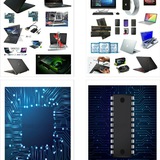If the latest and greatest speeds and efficiencies that come with an NVMe SSD is a must have, then there’s a couple things to keep in mind. First, make sure the computer receiving the drive has the M.2 connector type for that type of drive. Most consumer NVMe drives only support the M.2 “M” key (5 pins), which is the M.2 physical edge connector. SATA based SSDs use the “B” key (6 pins) but there are some connectors that feature “B + M” which can accept both a SATA and NVMe drive. Second, the computer needs to be compatible with supporting and booting to an NVMe drive. Many older computers and operating systems may not support booting to or even recognize an NVMe drive due to how new it is. Third, expect to pay a premium. The PCIe NVMe drives are the newest and greatest of the SSD consumer market, so cutting edge is top price. And finally, make sure an NVMe drive fits the usage case scenario. The performance improvement will only be seen with large read/writes to and from the drive or large amounts of small read/writes. Computers will boot faster, files will transfer and search faster, programs will boot faster, but it won’t make a Facebook page load any faster.
In conclusion, SSDs are quickly becoming ubiquitous in the computing world and for good reason. Their prices are plummeting, their speeds are unmatched, they’re smaller fitting into thinner systems, and they’re far less likely to fail, especially after a drop or shake of the device. If you have an old computer with slow loading times in need of a performance boost, a great speed-augmenting solution is to buy a SATA SSD. But if being cutting edge and speed is what is what you’re looking for, nothing that beats a PCIe NVMe M.2 drive.
@geekstechcomputers
In conclusion, SSDs are quickly becoming ubiquitous in the computing world and for good reason. Their prices are plummeting, their speeds are unmatched, they’re smaller fitting into thinner systems, and they’re far less likely to fail, especially after a drop or shake of the device. If you have an old computer with slow loading times in need of a performance boost, a great speed-augmenting solution is to buy a SATA SSD. But if being cutting edge and speed is what is what you’re looking for, nothing that beats a PCIe NVMe M.2 drive.
@geekstechcomputers
[OFFICIAL] Get Valid and Full DVD Ripper License for Windows 10/8/7, Up to 75% Off!
https://www.winxdvd.com/specialoffer/windows-10-dvd-ripper.htm?ttref=htg
https://www.winxdvd.com/specialoffer/windows-10-dvd-ripper.htm?ttref=htg
Winxdvd
[OFFICIAL] Get Valid and Full DVD Ripper License for Windows 10/8/7, Up to 75% Off!
Discount offer - get valid and full license of the best DVD ripper for Windows 10/8/7. The lowest price to seize the ultimate disc to digital solution and diverse video DVD software for Windows 10.
What Are Nits of Brightness on a TV or Other Display?
https://www.howtogeek.com/402006/what-are-nits-of-brightness-on-a-tv/
https://www.howtogeek.com/402006/what-are-nits-of-brightness-on-a-tv/
How-To Geek
What Are Nits of Brightness on a TV or Other Display?
The competition between TV and display manufacturers has been heating up rapidly, and everyone is talking about how many “nits” their displays have. But what even is a nit? And why should you care?
What Is the “God Mode” Folder in Windows 10, and How Do I Enable It?
https://www.howtogeek.com/402458/enable-god-mode-in-windows-10/
https://www.howtogeek.com/402458/enable-god-mode-in-windows-10/
How-To Geek
What Is the "God Mode" Folder in Windows 10, and How Do I Enable It?
It's a popular feature.
Looking for a Microsoft Signature Edition PC? Here’s What to Do Instead
https://www.howtogeek.com/402888/looking-for-a-microsoft-signature-edition-pc-heres-what-to-do-instead/
https://www.howtogeek.com/402888/looking-for-a-microsoft-signature-edition-pc-heres-what-to-do-instead/
How-To Geek
Looking for a Microsoft Signature Edition PC? Here’s What to Do Instead
Microsoft’s Signature Edition PCs were one of the Microsoft Store’s best offerings since Microsoft used a clean copy of Windows with no bloatware on these PCs. Microsoft no longer makes Signature Edition PCs, but you can turn any PC into one.
Mini laptops now available from 9k only clean & new inbox me @mashthegeek
